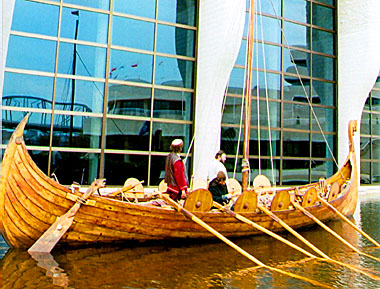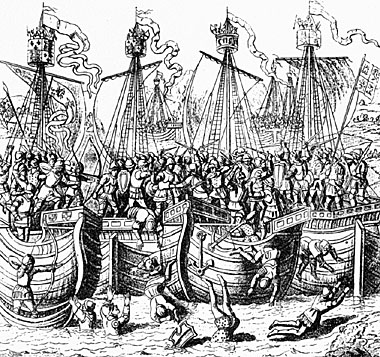
The Mjøsen Lange a reconstructed
Viking long ship, beside the Canadian Museum of Civilization, 2002.
Photo © S. Alsford
Vessels after which the Mjøsen Lange was modelled were developed over the course of centuries, and are popularly associated with the Vikings, who used them primarily for fishing and raiding, while the shorter but broader knarr was used for trading voyages. Both Normans and Anglo-Saxons used variants of the Viking long ship type in and before 1066 . A light galley-style vessel, it could be powered by the single square sail, or by rowers, whereas the knarr relied more on its sail. A large oar towards the stern (as in the example above) was used for steering.
When rowed the long ship had good speed and manoeuvrability; it was well suited for travel in shallow or sheltered waters, such as along the coast, and was effective in raiding English settlements by entering river estuaries and even venturing far up-river, where other warships could not go. It could be run up against a shore, without the need for special docking facilities, disembark its soldiers quickly to launch an attack, and thereafter be shoved and rowed out for a quick escape.
The Mjøsen Lange was constructed by a Norwegian non-profit foundation in 1995, using traditional techniques where possible. It represents a smaller type of long ship, being almost 35 feet long and equipped for a small crew of 10 oarsmen and a steersman, who stood at the rear of the ship. Its mast is 7.85 metres long and its sail spread is 3.7 by 4.5 metres.
The type of ship used by the Normans in their invasion of England had, by the
thirteenth century, been developed into warships that had fighting platforms,
called castles, stern and aft. Whereas warships of Ancient Greece and Tudor England
alike were weapons in their own right, from the time of the Romans until the
Late Middle Ages, warships were used primarily as bases from which to launch
infantry attacks, either by landing troops on enemy territory, or by boarding an
enemy vessel.
A naval battle entailed ships manoeuvring alongside each other, so that the soldiers aboard could first shoot missiles of various types at each other, then come directly to grips. This was the same fundamental strategy used in land battles, and is assumed to have been as true for Viking naval battles as for those in the Late Middle Ages. If fleets encountered each other close to shore (which seems often to have been an aim), an alternative strategy would be to force enemy vessels ashore, so that troops could engage there. Ships were valuable, so it was preferable to eliminate enemy crews and capture their craft, rather than sink them, if possible.

A line drawing rendering of a colour
illustration from a fifteenth-century copy of Froissart's history
of the Hundred Years War. In this artist's conception
of a coastal encounter (accurate in its broad strokes),
four English and French ships appear in the foreground,
with several others behind. In addition to the general melee
between troops attempting to board in the pair of ships
that have already come alongside, we can see crossbowmen
and longbowmen positioned on the main castles, as well as on
a ship's boat (bottom left-hand corner), while spear-throwers
and archers are stationed on secondary castles atop the masts,
a feature better known to us as the crowsnest.
No cannon are visible.
Handguns were first used on ships around the mid-fourteenth century, and later in the century light cannon, small in size and number, began to be mounted shipboard. But they simply supplemented other projectile weapons used was against the personnel of enemy ships, as a prelude to boarding, or perhaps to disable their vessel by shooting down the mast. For that purpose guns were mounted usually atop the castles or sometimes at the prow.
As heavier cannon were introduced in the fifteenth century it made ships too top-heavy; transferring them to a lower position changed them into weapons to disable or sink opposing ships and thus gradually transformed naval warfare in the post-medieval period, although there continued to be a reliance on the boarding tactic. The Spanish, most notably, focused primarily on boarding (which necessitated larger, less manoeuvrable ships to carry large numbers of troops) up until the Armada. But other changes in ship design were making boarding more difficult.